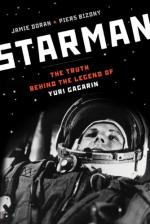|
This section contains 269 words (approx. 1 page at 300 words per page) |
Russian Cosmonaut; First Human in Space 1934-1968
On April 12, 1961, at age twenty-seven, Yuri Gagarin, of the Soviet Union, became the first human in space. He completed one orbit of Earth before descending in his Vostok 1 spacecraft and parachuting the last 3 kilometers (2 miles) to the ground. Instantly, this Russian from a collective farm in Klushino became a world hero and household name.
After graduating from high school, Gagarin attended a machinery school to train as an ironworker. He then attended the industrial and technical school in Saratov. While there, he joined a flying club and became an amateur pilot. On the recommendation of an instructor he was accepted into the Orenburg Aviation School in 1955. Gagarin trained as a fighter pilot with the Northern Fleet. Inspired by the Soviet Union's Luna 3 satellite, which was the first to return images of the Moon's farside, he applied to become a cosmonaut and was accepted.
 Russian Yuri Gagarin became the first person in space when he orbited Earth on April 12, 1961.
Russian Yuri Gagarin became the first person in space when he orbited Earth on April 12, 1961.
Gagarin's orbital flight in 1961 was a pivotal moment in the "space race" between the Soviet Union and the United States. The United States sent Alan Shepard into space on a suborbital flight three weeks after Gagarin's flight. After his orbital flight, Gagarin made many public appearances and in 1966 began training for a Soyuz flight. Unfortunately, at the age of thirty-four, he and a flight instructor were killed in the crash of their MiG-15 training jet.
See Also
Cosmonauts (Volume 3);; Government Space Programs (Volume 2);; History of Humans in Space (Volume 3);; Shepard, Alan (Volume 3).
Bibliography
Englebert, Phillis, ed. Astronomy and Space. Detroit, MI: UXL, 1997.
|
This section contains 269 words (approx. 1 page at 300 words per page) |


